The electrical components of the robot depend heavily on requirements set by the other systems; motor voltage, current draw, sensors necessary for an intelligent control system, and size and weight restrictions all factor into the selection of parts. The electrical system collects data with sensors and outputs the power that drives the other systems. It allows the microcontroller to exert control on the rest of the robot, so it can be roughly equated to the robot’s nervous system.
Microcontroller
The microcontroller is the brain of the robot, taking in data, performing computations, and controlling the actuators. There were several criteria important to choosing a microcontroller, such as digital I/O, available communication protocols, reliability and support. The ARM Cortex-M4 microprocessor was a favorable solution. The Cortex-M series is known for optimization of low cost, high performance, and low power. The M4F specifically is a 32-bit processor with a floating point unit (FPU). This is helpful for the calculations required in dealing with various sensors.
Once the microprocessor was chosen, the microcontroller had to be picked. The top choices were the MSP432, STM32 L4 and AVR UC3 C-Series. The MSP432 was the final decision based on the features, including a 24-channel 14-bit analog to digital converter (ADC), 6 timers, UART, I2C and SPI communication interfaces, and a JTAG interface for debugging. For prototyping, the MSP432 is conveniently available in a development board, which features breakout pins, LEDs, switches, and available BoosterPacks for further functionality.
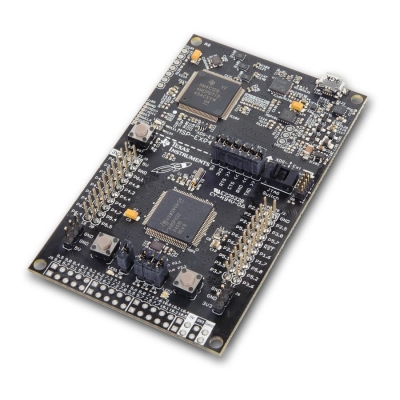
MSP-EXP432P401R (MSP432 Launchpad)
Sensors
Sensors are the eyes and ears of the robot, providing input for the microcontroller. The sensors are split up into two categories: essential and payload. Essential sensors are used for determining orientation, depth, and other important information about the robot’s state. Payload sensors are optional, used for data collection of the environment or other mission specific information. For this prototype, there are no payload sensors, but in the future they could be integrated with reasonable ease.
Below is the decision matrix for selecting the essential pressure sensor.
| Weight | Barometric Pressure Sensor | Submersible Pressure Transducer | MEMS Pressure Sensor | |||
Resolution | 2 | 2 | 1 | 1 | |||
Range | 2 | -1 | 1 | 2 | |||
Power Requirements | 2 | 1 | -1 | 1 | |||
Size | 1 | 2 | 0 | 2 | |||
Cost | 1 | 2 | 1 | 1 | |||
Unweighted Totals | 6 | 2 | 7 | ||||
Weighted Totals | 8 | 3 | 11 | ||||
Pressure Sensor Characteristics
Inertial Measurement Unit
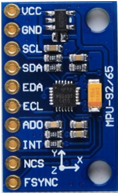
MPU-9250
The first essential sensor board is the inertial measurement unit (IMU). This is a chip common for consumer electronics equipment, such as smartphones and wearable sensors, due to motion processing and MotionFusion algorithms.5 The MPU-9150 was originally chosen for its 9-axis measurement from a 3-axis accelerometer, gyroscope and magnetometer. A breakout board was available from SparkFun with standard header pins for an easy interface. This chip was later replaced with the MPU-9250 - a newer model of the now-deprecated MPU-9150.
This board communicates with the MSP432 via I2C. The MSP432 sends initial configuration information on powerup. Afterwards, certain registers on the board contain the continuously updated information for each axis of each sensor. The MSP432 then only has to send a request detailing the appropriate register, specified in the datasheet, and wait to receive the information which can be stored and used for processing. These values provide information about orientation that can applied to the control system.
Pressure Sensor
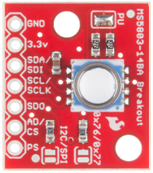
MS5803-14BA Pressure Sensor
The second essential sensor is the pressure sensor that monitors the robot’s depth. The MS5803-14BA was selected due to its wide range, high precision, and availability on a breakout board from SparkFun for ease of use. This sensor is instrumental in giving the robot information about its position and developing failsafe systems.
There are two communication protocols available with this board: I2C and SPI. While SPI can transfer data at a higher rate, it requires more pins than I2C. For this application, high speed sensor updates are not required. I2C was chosen both for these reasons and to match the IMU. The way I2C works, there can be one master with several slaves on the same bus. The MSP432 functions as the master and can continuously switch between the two sensors on the I2C bus to update the information being processed.
An advantage of getting this sensor on the breakout board is the inclusion of an ADC. The MSP432 can send a request to the sensor board to convert the most recent value, wait a short time for the conversion to happen, then receive the updated sensor value. The result comes in a integer that can be converted into the pressure in millibar. The calculations require several factory calibrated values that are stored in the PROM of the chip. These constants are specific to each sensor and are easily retrieved by reading specific registers.
Power Systems
Batteries
The robot has two major systems requiring power. The first system is the propulsion, requiring a 12V battery, with significant current draw. This draws power only when the robot is pressurizing the hydraulic system or flapping.The second system, which consists of the microcontroller and sensors, requires 5V. The battery needed to be energy dense, rechargeable, stable long term, non-combustible, and environmentally friendly.7 With these criteria, two types of batteries were considered for selection: lithium polymer (LiPo) and lithium iron phosphate (LiFePo4).
LiPo batteries were considered for their high energy density and commercial availability. LiPo batteries are commonly used and readily available for purchase.This eliminated any wait time on a custom order or risk of backordering. LiPo batteries are the lightest lithium battery, while still maintaining a high energy density, ensuring no unnecessary weight is added to the system. These batteries have a long life, are environmentally friendly, and are much safer than traditional lead-acid batteries. LiPo batteries are not perfectly charge stable, potentially exposing sensitive equipment to voltage fluctuations. The pump and valve system is capable of withstanding small disturbances, however the sensors and microcontrollers could be susceptible to damage.
LiFePo4 batteries, a type of lithium ion battery, were a promising option due to their increased performance when compared to other lithium polymer batteries. Being the safest lithium battery, they does not pose a risk to safety or the environment, and maintain the highest energy density of all lithium batteries to date. Additionally, LiFePo4 batteries have a minimum life span of 3 years from production date.
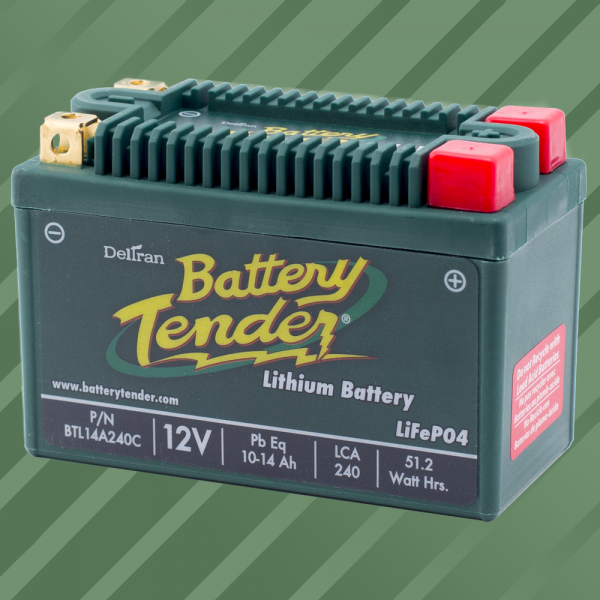
LiFePo4 Battery
When actually purchasing the batteries, a small, light 12V LiFePo4 battery was found, with an included charging circuit, for a relatively low price. At 1.76lb and almost 50 in3, this battery can fit easily in the hull without excessively disturbing the weight distribution.
At this point, rather than purchase a separate battery for the electronics, it was discovered that a voltage regulator would introduce significant price savings without significant energy loss. The LT1085 voltage regulator is capable of shifting 12V to a stable 5V, with the implementation of some capacitors for stability. It is a relatively efficient chip that can handle 3A, which is enough current for all of the electronics. The other benefit of the voltage regulator is that the 5V output remains stable, preventing damage to the electronics from fluctuations.
Motor Drivers
In order to control the valves while providing the amount of power needed to switch and hold valve states, several L2930 H-Bridge motor drivers are used. This H-Bridge integrated chip takes an input signal from the microcontroller and adjusts the voltage of its output pins accordingly. The power output by the chip comes from battery power connected directly to the chip and is therefore not limited by the current ratings of the microcontroller. Each motor driver chip has four inputs and outputs, enough for four valves. However, for organizational purposes, four chips are used with three valves each so that every half-fin is attached its own motor driver.
The gear pump draws a steady 3.5A, which is more than the L2930s can provide, so a different motor driver chip had to be selected. The Pololu G2 High-Power Motor Driver 24v13 can handle 6.5-40V, well over what would be required for a safety margin for ripple voltage on the supply line. The continuous current capacity for the motor driver is rated at 13A, allowing for an inrush current of almost 400% of nominal current consumption.
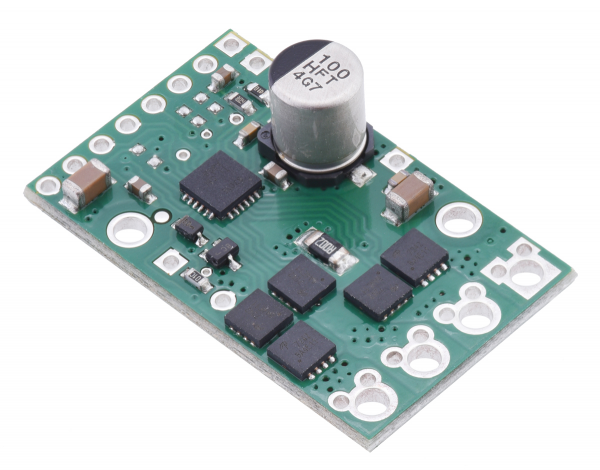
Pololu G2 High-Power Motor Driver 24v13
